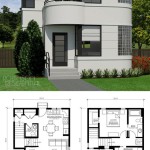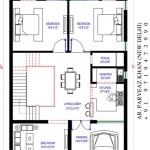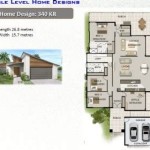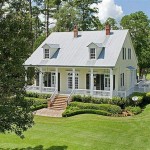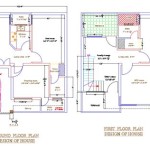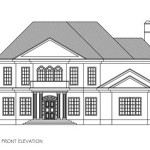Old Bungalow Home Plans: A Journey Through Architectural History and Design
Old bungalow home plans represent a significant chapter in the architectural history of residential housing. These designs, originating in India and later popularized in the West, offer a unique blend of stylistic features, emphasizing functionality, affordability, and connection to the surrounding environment. Understanding the nuances of these plans requires exploring their historical context, identifying key design elements, and appreciating their enduring appeal in modern home design.
The term "bungalow" derives from the Gujarati word "bangla," referring to a low-slung, single-story house common in Bengal, India. During the British colonial period, the bungalow-style dwelling was adopted for use by administrators and officials. Its adaptability to various climates and its relative ease of construction contributed to its widespread adoption across the Indian subcontinent. Key features of these early bungalows included wide verandas, which provided shade and ventilation, and a layout that encouraged cross-ventilation, crucial for maintaining comfort in tropical climates.
The bungalow gained popularity in the United States and other Western countries during the early 20th century. Architects and builders adapted the original Indian bungalow style to suit local climates and aesthetic preferences, resulting in various regional variations. The Craftsman bungalow, California bungalow, and Chicago bungalow are notable examples, each reflecting distinct regional influences. The affordability and practicality of bungalows made them particularly appealing to the growing middle class, contributing to their proliferation as a housing type.
Key Features of Old Bungalow Home Plans
Several distinctive features characterize old bungalow home plans. These elements contribute to the unique aesthetic and functional appeal of these dwellings. Recognizing these features is crucial for appreciating the design intent and for identifying authentic bungalow characteristics.
A prominent feature is the low-pitched roof, often with wide overhanging eaves. This design element provides shade and protection from the elements, contributing to energy efficiency and preventing water damage. The roof is typically gabled or hipped, adding to the visual interest and contributing to the overall architectural style. Deep eaves also create covered outdoor spaces, extending the living area and providing shelter from sun and rain.
Wide, welcoming verandas are another defining characteristic. These porches, often extending along the front or sides of the house, serve as transitional spaces between the interior and exterior. Verandas provide a place for relaxation and socializing, fostering a connection with the surrounding landscape. In many bungalow designs, the veranda is an integral part of the living space, serving as an outdoor room during favorable weather conditions.
Open floor plans, while not always present in the earliest bungalow designs, became increasingly common as the style evolved. The emphasis on open space promotes a sense of spaciousness and facilitates natural light flow throughout the interior. Living rooms, dining rooms, and kitchens were often connected, creating a more communal living environment. This design approach catered to the evolving social norms of the early 20th century, emphasizing informality and family interaction.
Built-in cabinetry and storage solutions are frequently found in old bungalow home plans. These features maximize space utilization and contribute to the overall functionality of the home. Built-in bookshelves, window seats with storage, and dining room buffets were common elements, reflecting the emphasis on practicality and efficient use of space. These built-ins were often crafted from high-quality materials, adding to the charm and character of the home.
Natural materials, such as wood, stone, and brick, are commonly used in bungalow construction. These materials contribute to the warmth and authenticity of the design. Wood siding, shingle roofing, and exposed rafter tails are characteristic elements. Interior finishes often include hardwood floors, wood trim, and natural stone fireplaces, enhancing the rustic and organic aesthetic. The use of natural materials reinforces the connection to the surrounding environment and creates a comfortable and inviting living space.
Regional Variations in Bungalow Design
The bungalow style evolved and adapted as it spread across different regions, resulting in distinct variations that reflect local architectural traditions and environmental conditions. Understanding these regional differences is essential for appreciating the diversity and adaptability of the bungalow design.
The Craftsman bungalow, popular in California and the Pacific Northwest, emphasizes handcrafted details and natural materials. Key features include exposed rafter tails, deep porches supported by thick columns, and a focus on natural light. Craftsman bungalows often feature intricate woodwork, exposed beams, and built-in cabinetry. The style reflects the Arts and Crafts movement's emphasis on craftsmanship, simplicity, and functionality. This style is often associated with the names of architects and designers like Greene and Greene who pioneered the Craftsman aesthetic.
The California bungalow exhibits a more relaxed and informal style. Often featuring stucco exteriors, low-pitched roofs, and wide, welcoming porches, California bungalows emphasize indoor-outdoor living. The style often incorporates elements of Spanish Colonial architecture, such as arched doorways and courtyards. The California bungalow reflects the region's mild climate and emphasis on outdoor recreation.
The Chicago bungalow, prevalent in the Midwestern United States, is characterized by its brick construction, raised foundation, and rectangular floor plan. Chicago bungalows often feature a bay window or sunroom, providing additional natural light and living space. The style is known for its practicality and affordability, reflecting the working-class communities in which they were built. While simpler in design than some other bungalow styles, the Chicago bungalow remains a beloved and recognizable architectural form.
The Enduring Appeal and Modern Adaptations
Old bungalow home plans continue to hold appeal for homeowners seeking a combination of character, practicality, and affordability. The enduring popularity of the bungalow reflects its timeless design principles and its ability to adapt to modern living needs. Many homeowners are drawn to the charm and historical significance of these homes, seeking to preserve and restore their original features.
Modern adaptations of bungalow designs often incorporate contemporary amenities and energy-efficient technologies while retaining the original architectural character. Open floor plans, updated kitchens, and expanded bathrooms are common modifications. Sustainable building practices, such as the use of recycled materials and energy-efficient windows, are also incorporated to improve the environmental performance of these homes. The goal is to create a comfortable and functional living space that respects the historical integrity of the bungalow design.
The relatively small size and simple layout of many bungalows make them ideal for downsizing or for first-time homebuyers. The manageable size allows for efficient heating and cooling, reducing utility costs. The single-story design is also appealing to individuals with mobility limitations, providing easy access to all areas of the home. The bungalow offers a practical and affordable housing option for a wide range of homeowners.
Preserving the historical character of old bungalow home plans is a priority for many homeowners. Restoring original features, such as hardwood floors, wood trim, and built-in cabinetry, is a common undertaking. Maintaining the original exterior details, such as the roofline, porch columns, and siding, is also important for preserving the architectural integrity of the home. By carefully restoring and preserving these features, homeowners can ensure that these historic homes continue to be enjoyed for generations to come.
In conclusion, old bungalow home plans represent a rich and diverse architectural heritage. Their enduring appeal lies in their combination of practicality, affordability, and charming design features. From the low-pitched roofs and wide verandas to the open floor plans and natural materials, bungalows offer a unique and timeless living experience. By understanding the historical context, identifying key design elements, and appreciating the regional variations, homeowners and enthusiasts can continue to celebrate and preserve these iconic homes.

Plan No R 856 C 1918 Cottage House By A E Stillwell Vintage Bungalows Plans Transition Bungalow Floor

Small House Craftsman Plans Bungalow Design

1922 Craftsman Style Bunglow House Plan No L 114 E W Stillwell Co Bungalow Floor Plans Vintage

Charming 1920s Home Design

1920s Classic Bungalow Small Homes Books Of A Thousand Atterbury Floor Plans Vintage House Craftsman

Practical Homes 1926 Craftsman House Plans Bungalow Exterior Design Pictures

1918 Bungalow House Plan By E W Stillwell Los Angeles Craftsman Home

1914 Tiny Cottage Bungalow 600 Sq Ft George Palmer Telling Old House Plans For Small Homes

Vintage Home Design Archives The Inn

Brick Bungalow 1927 Homes Of Lasting Charm The Saranac Vintage House Plans How To Plan

